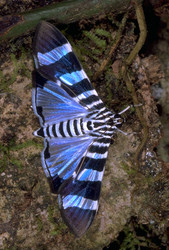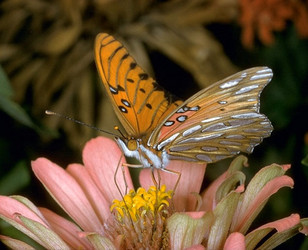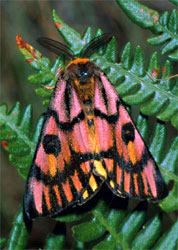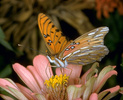Lepidoptera
Moths and Butterflies



This tree diagram shows the relationships between several groups of organisms.
The root of the current tree connects the organisms featured in this tree to their containing group and the rest of the Tree of Life. The basal branching point in the tree represents the ancestor of the other groups in the tree. This ancestor diversified over time into several descendent subgroups, which are represented as internal nodes and terminal taxa to the right.

You can click on the root to travel down the Tree of Life all the way to the root of all Life, and you can click on the names of descendent subgroups to travel up the Tree of Life all the way to individual species.
For more information on ToL tree formatting, please see Interpreting the Tree or Classification. To learn more about phylogenetic trees, please visit our Phylogenetic Biology pages.
close boxIntroduction
Most larvae are phytophagous; some eat other insects, a few are ectoparastoids. Most are terrestrial.References
Davis, D. R. 1986. A new family of monotrysian moths from austral South America (Lepidoptera: Palaephatidae), with a phylogenetic review of the Monotrysia. Smithsonian Contributions to Zoology 434: 1-202.
Friedlander, T. P., J. C. Regier, C. Mitter, and D. L. Wagner. 1996. A nuclear gene for higher level phylogenetics: phosphoenolpyruvate carboxykinase tracks Mesozoic-aged divergences within Lepidoptera (Insecta). Molecular Biology and Evolution 13:594-604.
Heppner, J. B. 1991. Faunal regions and the diversity of Lepidoptera. Tropical Lepidoptera 2(Supplement 1):1-85.
Kobayashi, Y. and H. Ando. 1988. Phylogenetic relationships among the lepidopteran and trichopteran suborders (Insecta) from the embryological standpoint. Zeitschrift Fuer Zoologische Systematik Und Evolutionsforschung 26(3): 186-210.
Krenn, H. W. and N. P. Kristensen. 2000. Early evolution of the proboscis of Lepidoptera (Insecta): external morphology of the galea in basal glossatan moth lineages, with remarks on the origin of the pilifers. Zoologischer Anzeiger 239:179-196.
Kristensen, N. P. 1984. Studies on the morphology and systematics of primitive Lepidoptera (Insecta). Steenstrupia 10: 141-191.
Kristensen, N. P. 1999. The Non-Glossatan Moths. Pages 41-49 in: Lepidoptera: Moths and Butterflies. 1. Evolution, Systematics, and Biogeography. Handbook of Zoology Vol. IV, Part 35. N. P. Kristensen, ed. De Gruyter, Berlin and New York.
Kristensen, N. P. 1999. The Homoneurous Glossata. Pages 51-63 in: Lepidoptera: Moths and Butterflies. 1. Evolution, Systematics, and Biogeography. Handbook of Zoology Vol. IV, Part 35. N. P. Kristensen, ed. De Gruyter, Berlin and New York.
Kristensen, N. P., M. Scoble, and O. Karsholt. 2007. Lepidoptera phylogeny and systematics: the state of inventorying moth and butterfly diversity. Pages 699-747 in: Zhang, Z.-Q. & Shear, W.A., eds. Linnaeus Tercentenary: Progress in Invertebrate Taxonomy. Zootaxa 1668:1–766.
Kristensen, N. P. and A. W. Skalski. 1999. Phylogeny and paleontology. Pages 7-25 in: Lepidoptera: Moths and Butterflies. 1. Evolution, Systematics, and Biogeography. Handbook of Zoology Vol. IV, Part 35. N. P. Kristensen, ed. De Gruyter, Berlin and New York.
Nielsen, E. S. 1985. Primitive (non-ditrysian) Lepidoptera of the Andes: diversity, distribution, biology and phylogenetic relationships. In G. Lamas (ed.), Second Symposium on Neotropical Lepidoptera. Arequipa, Peru 1983. Santa Barbara, CA, Lepidoptera Research Foundation. 1-16.
Nielsen, E. S. 1989. Phylogeny of major lepidopteran groups. In B. Fernholm, K. Bremer and H. Jörnvall (ed.), The Hierarchy of Life. Amsterdam, Elsevier. 281-294.
Nielsen, E. S. and N. P. Kristensen, N. P. 1996. The Australian moth family Lophocoronidae and the basal phylogeny of the Lepidoptera Glossata. Invertebrate Taxonomy 10:1199-1302.
Robbins, R. K. 1988. Comparative morphology of the butterfly foreleg coxa and trochanter (Lepidoptera) and its systematic implications. Proceedings Of The Entomological Society Of Washington 90(2): 133-154.
Scoble, M. J. 1992. The Lepidoptera: Form, Function and Diversity. Oxford: Oxford University Press.
Shields, O. 1988. Mesozoic history and neontology of Lepidoptera in relation to Trichoptera, Mecoptera, and angiosperms. Journal Of Paleontology 62(2): 251-258.
Simonsen, T. J. 2001. The wing vestiture of the non-ditrysian Lepidoptera (Insecta). Comparative morphology and phylogenetic implications. Acta Zoologica 82(4): 275-298.
Sonnenschein, M. and C. L. Haeuser. 1990. Presence of only eupyrene spermatozoa in adult males of the genus Micropterix Huebner and its phylogenetic significance (Lepidoptera: Zeugloptera, Micropterigidae). International Journal Of Insect Morphology And Embryology 19(5-6): 269-276.
Stekol'nikov, A. A. and M. A. Pyatin. 1990. Evolution of the female reproductive system of Lepidoptera: The genital ducts, spermatheca, bursa copulatrix, colleterial glands. Entomologicheskoe Obozrenie 69(4): 747-763.
Whalley, P. 1986. A review of the current fossil evidence of Lepidoptera in the Mesozoic. Biological Journal of the Linnean Society 28(3):253-272.
Wiegmann, B. M., C. Mitter, J. C. Regier, T. P. Friedlander, D. M. Wagner, and E. S. Nielsen. 2000. Nuclear genes resolve Mesozoic-aged divergences in the insect order Lepidoptera. Molecular Phylogenetics and Evolution 15:242-259.
Wiegmann, B. M., J. C. Regier, and C. Mitter. 2002. Combined molecular and morphological evidence on the phylogeny of the earliest lepidopteran lineages. Zoologica Scripta 31:67-81.
Information on the Internet
- Leptree.net. An international, community collaboration dedicated to advancing progress toward a phylogenetic tree for all Lepidoptera.
- LepIndex. The Global Lepidoptera Names Index. Natural History Museum, London.
- Butterflies & Moths of the World: Generic Names & their Type-species. Brian Pitkin and Paul Jenkins. Natural History Museum, London.
- HOSTS - a Database of the World's Lepidopteran Hostplants. Natural History Museum, London.
- Butterflies and Moths of North America. Big Sky Institute at Montana State University and the NBII Mountain Prairie Information Node.
- Michigan Lepidoptera Survey
- Moths and Butterflies of Georgia and the Southeastern United States
- The Moths of Southeastern Arizona
- Key to Families of Macromoths in California
- The Moths of Canada
- Association for Tropical Lepidoptera
- Tropical Moths
- Catalogue of the Lepidoptera of the French Antilles.
- The Butterflies and Moths of Israel
- Moths and Butterflies of Europe and North Africa
- UKmoths
- Lepidoptera and some other life forms
- Checklist of Finnish Lepidoptera
- Butterflies and Moths of the Netherlands
- Colour Atlas of the Siberian Lepidoptera
- Caterpillars: especially Australian ones.
- The Moths of Borneo
- The Lepidopterists' Society
- Moth Collecting and Curation Techniques
- Iridescence in Lepidoptera
Title Illustrations

| Scientific Name | Pyralidae |
|---|---|
| Location | Poco Sol, Costa Rica |
| Comments | Snout moth (Neolepidoptera: Pyraloidea) |
| Specimen Condition | Live Specimen |
| Copyright |
© 1990 Greg and Marybeth Dimijian

|
| Scientific Name | Agraulis vanillae |
|---|---|
| Comments | Gulf fritillary butterfly (Neolepidoptera: Nymphalidae) |
| Creator | Photograph by Stennett S. Heaton |
| Specimen Condition | Live Specimen |
| Source | Agraulis vanillae; Gulf Fritillary butterfly |
| Source Collection | CalPhotos |
| Copyright |
© 2001 California Academy of Sciences

|
| Scientific Name | Hemileuca eglanterina |
|---|---|
| Location | Mima Prairie, Thurston County (Washington, US) |
| Comments | Elegant sheep moth (Neolepidoptera: Saturniidae) |
| Specimen Condition | Live Specimen |
| Source | Hemileuca eglanterina; Elegant Sheep Moth |
| Source Collection | CalPhotos |
| Copyright | © 1999 William Leonard |
About This Page
Page copyright © 2003
 Page: Tree of Life
Lepidoptera. Moths and Butterflies.
The TEXT of this page is licensed under the
Creative Commons Attribution-NonCommercial License - Version 3.0. Note that images and other media
featured on this page are each governed by their own license, and they may or may not be available
for reuse. Click on an image or a media link to access the media data window, which provides the
relevant licensing information. For the general terms and conditions of ToL material reuse and
redistribution, please see the Tree of Life Copyright
Policies.
Page: Tree of Life
Lepidoptera. Moths and Butterflies.
The TEXT of this page is licensed under the
Creative Commons Attribution-NonCommercial License - Version 3.0. Note that images and other media
featured on this page are each governed by their own license, and they may or may not be available
for reuse. Click on an image or a media link to access the media data window, which provides the
relevant licensing information. For the general terms and conditions of ToL material reuse and
redistribution, please see the Tree of Life Copyright
Policies.
Citing this page:
Tree of Life Web Project. 2003. Lepidoptera. Moths and Butterflies. Version 01 January 2003 (temporary). http://tolweb.org/Lepidoptera/8231/2003.01.01 in The Tree of Life Web Project, http://tolweb.org/











 Go to quick links
Go to quick search
Go to navigation for this section of the ToL site
Go to detailed links for the ToL site
Go to quick links
Go to quick search
Go to navigation for this section of the ToL site
Go to detailed links for the ToL site